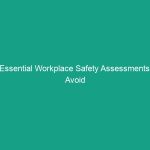Must-Know Rope Safety Tips: Avoid Critical Risks on the Job Site
Good morning team,
Today, we’re going to discuss a crucial topic that impacts our daily operations: rope Safety. Understanding how to work safely with ropes is essential to ensure that everyone goes home safe and sound at the end of the day. Ropes are commonly used in various tasks, from lifting and pulling to securing loads. However, improper handling can lead to severe accidents. So, let’s dive into the must-know rope safety tips that can help us avoid critical risks on the job site.
Understanding Rope Safety
Rope safety refers to the practices and guidelines that ensure the safe use of ropes in various work environments. This includes understanding the types of ropes, their strengths and weaknesses, and how to use them correctly. Ropes are integral to many tasks, such as construction, rigging, and rescue operations. Misconceptions often arise regarding the strength and durability of ropes. For instance, many believe that all ropes are equal, but different materials have distinct properties that can greatly affect their performance.
Key Hazards, Risks, and Safety Considerations
When it comes to rope safety, several key Hazards and risks need to be addressed:
- Wear and Tear: Ropes can degrade over time due to environmental factors such as UV exposure, moisture, and abrasion. Regular inspections are crucial.
- Improper Use: Using the wrong type of rope for a specific job can lead to failure and accidents.
- Load Limit Exceedance: Each rope has a maximum load capacity. Exceeding this limit can result in catastrophic failure.
- Inadequate Knot Tying: Poorly tied knots can slip or come undone, causing loads to fall or shift unexpectedly.
Ignoring these safety protocols can lead to serious injuries or even fatalities. For example, in a case where a worker used a frayed rope to lift heavy equipment, the rope snapped, resulting in a serious accident. Understanding these risks is the first step in mitigating them.
Best Practices, Procedures, & Actionable Advice
To ensure rope safety on the job site, follow these Best Practices:
- Choose the Right Rope: Always select a rope that is appropriate for the task. Consider factors like the rope’s material, strength, and flexibility.
- Conduct Regular Inspections: Inspect ropes before each use. Look for signs of wear, fraying, or damage. If a rope doesn’t look right, don’t use it.
- Know the Load Capacity: Always adhere to the manufacturer’s specifications regarding load limits. Never exceed these limits.
- Use Proper Knot Techniques: Familiarize yourself with various knots and understand when to use them. Ensure that knots are tied securely and double-check them before use.
- Secure Load Properly: Ensure that the load is secured correctly using appropriate techniques and equipment to prevent slippage.
- Maintain a Safe Working Environment: Keep the work area free of debris and obstacles that could interfere with rope handling.
Here’s a real-world incident to illustrate the importance of these Best Practices: A crew was lifting a heavy beam with a rope that had not been inspected. The rope snapped due to unseen fraying, causing the beam to fall and injure a worker. This incident could have been avoided with proper Safety Measures in place.
Regulations, Standards, and Compliance
It’s essential to be aware of the Regulations and Standards that govern rope safety. The Occupational Safety and Health Administration (OSHA) provides guidelines that specify the safe use of ropes in various industries. Compliance with these standards not only ensures safety but also protects the company from legal ramifications.
Familiarize yourself with the relevant osha standards, and ensure that our practices are in line with these regulations. Remember, compliance is not just a legal obligation; it’s a commitment to your safety and the safety of your colleagues.
Employee Engagement & Discussion
Let’s take a moment to reflect on our own experiences. Have you encountered any safety challenges while using ropes? What steps did you take to address those issues? Sharing our experiences can help us learn from one another and improve our safety practices.
Conclusion & Key Takeaways
In conclusion, understanding and applying these rope safety tips is vital for preventing accidents on the job site. Always remember to:
- Choose the right rope for the job.
- Inspect ropes regularly for wear and damage.
- Adhere to load limits and proper knot techniques.
- Stay informed about regulations and compliance standards.
By prioritizing safety and being proactive in our practices, we can significantly reduce the risks associated with rope use. Thank you all for your attention and commitment to maintaining a safe work environment. Let’s continue to look out for one another and make safety our top priority.


